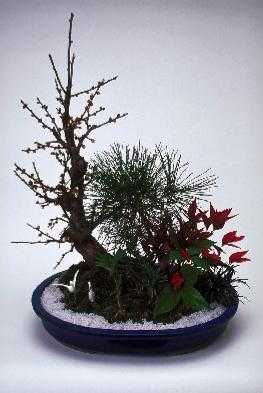松竹梅-梅 - Sho-chiku-bai - Japanese Apricot
The first flower we see in spring is often the Japanese Apricot (ume). The aroma of the blossom and its pure white color make it very popular with everyone as a garden plant. There are also red and pink blossoms. The lovely cherry blossom and the chrysanthemum are gorgeous in their seasons, but the Japanese apricot has something that sets it apart. It has a rugged appearance and its early arrival makes the people think of it as a courageous flower, worthy of admiration.
梅は、春の到来を告げる花です。そのかぐわしい香りと純白の花によって、梅はだれからも愛され、多くの庭園で見ることができます。赤やピンクの花もあります。 桜や菊は、それぞれの季節になると華麗な花を咲かせますが、梅にはまた別の魅力があります。梅はそれらの花に比べると素朴で、まだ肌寒い時期に咲くため、勇敢さを象徴する花とされています。
Its bravery and beauty are mentioned in many poems and it appears in pictures everywhere. Its juices were also used in dyeing cloth in the old days. One apricot pickle (ume boshi) a day is said to keep you in good health, and this may be true. In America we say, “An apple a day, keeps the doctor away.” There may be something important in both these customs. Perhaps they aid digestion.
梅の勇敢さと美しさは、多くの歌に歌われ、絵の題材として用いられています。梅の果汁を染料として使用した時代もありました。 健康を保つには、梅干しを一日一個食べると良いと言います。かなり信憑性のある話です。アメリカには、「一個のりんごが医者を遠ざける」という言葉があります。どちらも消化を助ける働きがあるのかもしれません。
Often raised as “Bonsai” (dwarf trees), the tiny trees are very beautiful and even though they look rough, I love the real feeling of the Japanese spirit it gives me. Its true name is Prunus Mume, from which “Ume” came. The people like the apricot with their food and it can be found in nearly every home. As a pickle, it is called ‘umeboshi’ and is pretty powerful fruit. A kind of drink is also made of this fruit, ‘ume-shu’ which is a kind of brandy. Power! Many people love this drink. In past times, ‘Ume’ was a name given to girls so they would endure life and troubles well. I have never heard it, but it sounds nice.
梅の盆栽は、あまり繊細には見えませんが、とても美しいものです。私はそこに、日本人の精神の神髄を見る思いがします。梅という名前は、元の名前「Prunus Mume」の訛ったものです。 梅を使った料理はたいへん好まれ、日本中の家庭で食べられています。塩漬にして作ったとても酸っぱい「梅干」や、「梅酒」というブランデーのような飲み物もあります。力が出る、というので多くの人が愛飲しています。昔は、?人生の困難に負けないように?と、女の子に「梅」と名付けることも多かったようです。実際にこの名前の女性に出会ったことはありません。しかし、良い名前だと思います。
We will find this hardy little plant in plays, such as ‘No’ and if it is possible or us to go to an ‘ume’ garden, we should go flower viewing there, in the right season, of course. The old ‘ume’ viewing parties were rather quiet when compared to the cherry blossom viewing parties, but it was probably because the weather was so cold in the apricot orchard. I understand that. I hate cold weather. Spring is for me. The wood of the Japanese apricot is very beautiful and used to be treasured in important places in the home.
また、能を始めとするさまざまな演劇にも梅は登場します。機会があれば、満開の梅の花を見に梅園に行ってみませんか。昔の梅の花見会は、桜の花見に比べてとても静かだったそうです。おそらく、梅が咲くころはまだ寒いことが理由かと思われます。私も寒いのは苦手ですから、よくわかります。春が一番です。 梅の木は非常に美しく、日本では家の中の最も重要な場所の建材として珍重されています。
Some tea implements are made of this wood, which is cherished for its beauty as well as the fact that it is, “Ume!” These implements are kept for decades, and even centuries, for their lovely feeling of “Wabi” and “Sabi.” Considering all these features, it is no wonder that the Japanese apricot is so important.
さらに、その美しさから、梅の木を用いた茶道具もあります。「うめえ」と言ったとか言わなかったとか。 こうした道具は、何十年、時には何百年も使用されています。これぞまさしく、わびさびの心です。梅のこうした役割を知るとき、日本人にとっての梅の大切さがしみじみと胸に伝わってきます。
